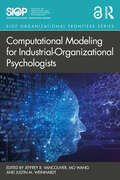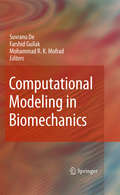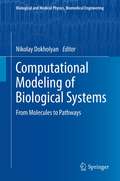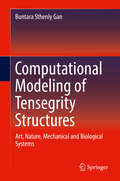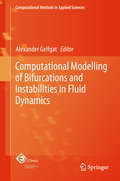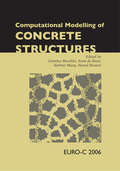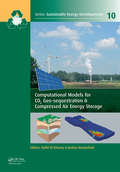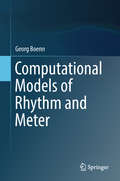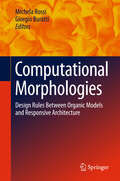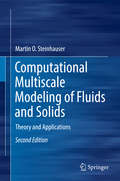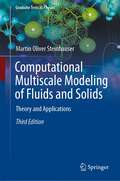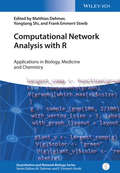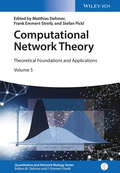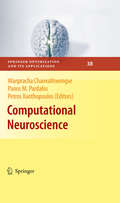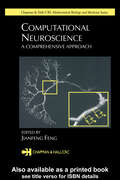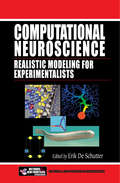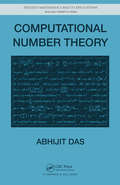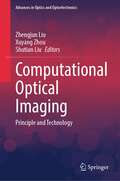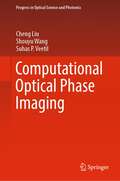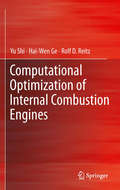- Table View
- List View
Computational Modeling for Industrial-Organizational Psychologists (SIOP Organizational Frontiers Series)
by Mo Wang Jeffrey B. Vancouver Justin M. WeinhardtThis collection provides a primer to the process and promise of computational modeling for industrial-organizational psychologists. With contributions by global experts in the field, the book is designed to expand readers’ appreciation for computational modeling via chapters focused on key modeling achievements in domains relevant to industrial-organizational psychology, including decision making in organizations, diversity and inclusion, learning and training, leadership, and teams. To move the use of computational modeling forward, the book includes specific how-to-chapters on two of the most commonly used modeling approaches: agent-based modeling and system dynamics modeling. It also gives guidance on how to evaluate these models qualitatively and quantitatively, and offers advice on how to read, review, and publish papers with computational models. The authors provide an extensive description of the myriad of values computational modeling can bring to the field, highlighting how they offer a more transparent, precise way to represent theories and can be simulated to offer a test of the internal consistency of a theory and allow for predictions. This is accompanied by an overview of the history of computational modeling as it relates to I-O psychology. Throughout, the authors reflect on computational modeling’s journey, looking back to its history as they imagine its future in I-O psychology. Each contribution demonstrates the value and opportunities computational modeling can provide the individual researcher, research teams, and fields of I-O psychology and management. This volume is an ideal resource for anyone interested in computational modeling, from scholarly consumers to computational model creators.
Computational Modeling for Industrial-Organizational Psychologists (SIOP Organizational Frontiers Series)
by Mo Wang Jeffrey B. Vancouver Justin M. WeinhardtThis collection provides a straightforward primer to the process and promise of computational modeling for industrial-organizational psychologists. Computational models offer I-O psychologists a more transparent, precise way to represent theories, and may be simulated, which provides a test of the internal consistency of a theory and allows for predictions. A timely volume as enthusiasm for computational modeling is growing and this volume provides a set of examples and chapters devoted to the steps in producing and testing models. Chapters are designed for a range of readership levels, and also address modeling for novices, fitting models to data, how to validate models using experiments, and how computational modeling may facilitate integration across disciplines.
Computational Modeling in Biomechanics
by Suvranu De Farshid Guilak Mohammad MofradAvailability of advanced computational technology has fundamentally altered the investigative paradigm in the field of biomechanics. Armed with sophisticated computational tools, researchers are seeking answers to fundamental questions by exploring complex biomechanical phenomena at the molecular, cellular, tissue and organ levels. The computational armamentarium includes such diverse tools as the ab initio quantum mechanical and molecular dynamics methods at the atomistic scales and the finite element, boundary element, meshfree as well as immersed boundary and lattice-Boltzmann methods at the continuum scales. Multiscale methods that link various scales are also being developed. While most applications require forward analysis, e.g., finding deformations and stresses as a result of loading, others involve determination of constitutive parameters based on tissue imaging and inverse analysis. This book provides a glimpse of the diverse and important roles that modern computational technology is playing in various areas of biomechanics including biofluids and mass transfer, cardiovascular mechanics, musculoskeletal mechanics, soft tissue mechanics, and biomolecular mechanics.
Computational Modeling of Biological Systems: From Molecules to Pathways (Biological and Medical Physics, Biomedical Engineering)
by Nikolay V DokholyanComputational modeling is emerging as a powerful new approach to study and manipulate biological systems. Multiple methods have been developed to model, visualize, and rationally alter systems at various length scales, starting from molecular modeling and design at atomic resolution to cellular pathways modeling and analysis. Higher time and length scale processes, such as molecular evolution, have also greatly benefited from new breeds of computational approaches. This book provides an overview of the established computational methods used for modeling biologically and medically relevant systems.
Computational Modeling of Cognition and Behavior
by Simon Farrell Stephan LewandowskyComputational modeling is now ubiquitous in psychology, and researchers who are not modelers may find it increasingly difficult to follow the theoretical developments in their field. This book presents an integrated framework for the development and application of models in psychology and related disciplines. Researchers and students are given the knowledge and tools to interpret models published in their area, as well as to develop, fit, and test their own models. Both the development of models and key features of any model are covered, as are the applications of models in a variety of domains across the behavioural sciences. A number of chapters are devoted to fitting models using maximum likelihood and Bayesian estimation, including fitting hierarchical and mixture models. Model comparison is described as a core philosophy of scientific inference, and the use of models to understand theories and advance scientific discourse is explained. Covers both basic and advanced topics to appeal to students and researchers alike. Provides a framework for using models in a variety of domains across psychology and related disciplines. Describes the application of models by walking through code written in R, a popular and free statistical programming language
Computational Modeling of Tensegrity Structures: Art, Nature, Mechanical and Biological Systems
by Buntara Sthenly GanThis book provides an in-depth, numerical investigation of tensegrity systems from a structural point of view, using the laws of fundamental mechanics for general pin-jointed systems with self-stressed mechanisms. Tensegrity structures have been known for decades, mostly as an art of form for monuments in architectural design. In Computational Modeling of Tensegrity Structures, Professor Buntara examines these formations, integrating perspectives from mechanics, robotics, and biology, emphasizing investigation of tensegrity structures for both inherent behaviors and their apparent ubiquity in nature. The author offers numerous examples and illustrative applications presented in detail and with relevant MATLAB codes. Combining a chapter on the analyses of tensegrity structures along with sections on computational modeling, design, and the latest applications of tensegrity structures, the book is ideal for R&D engineers and students working in a broad range of disciplines interested in structural design.
Computational Modelling of Bifurcations and Instabilities in Fluid Dynamics (Computational Methods in Applied Sciences #50)
by Alexander GelfgatInstabilities of fluid flows and the associated transitions between different possible flow states provide a fascinating set of problems that have attracted researchers for over a hundred years. This book addresses state-of-the-art developments in numerical techniques for computational modelling of fluid instabilities and related bifurcation structures, as well as providing comprehensive reviews of recently solved challenging problems in the field.
Computational Modelling of Concrete Structures: Proceedings of the EURO-C 2006 Conference, Mayrhofen, Austria, 27-30 March 2006
by Günther Meschke; René de Borst; Herbert Mang; Nenad BićanićThis conference proceedings brings together the work of researchers and practising engineers concerned with computational modelling of complex concrete, reinforced concrete and prestressed concrete structures in engineering practice. The subjects considered include computational mechanics of concrete and other cementitious materials, including masonry. Advanced discretisation methods and microstructural aspects within multi-field and multi-scale settings are discussed, as well as modelling formulations and constitutive modelling frameworks and novel experimental programmes. The conference also considered the need for reliable, high-quality analysis and design of concrete structures in regard to safety-critical structures, with a view to adopting these in codes of practice or recommendations. The book is of special interest to researchers in computational mechanics, and industry experts in complex nonlinear simulations of concrete structures.
Computational Models for CO2 Geo-sequestration & Compressed Air Energy Storage (Sustainable Energy Developments)
by Jochen Bundschuh Rafid Al-KhouryA comprehensive mathematical and computational modeling of CO2 Geosequestration and Compressed Air Energy StorageEnergy and environment are two interrelated issues of great concern to modern civilization. As the world population will soon reach eight billion, the demand for energy will dramatically increase, intensifying the use of fossil fuels. Ut
Computational Models for Polydisperse Particulate and Multiphase Systems
by Daniele L. Marchisio Rodney O. FoxProviding a clear description of the theory of polydisperse multiphase flows, with emphasis on the mesoscale modelling approach and its relationship with microscale and macroscale models, this all-inclusive introduction is ideal whether you are working in industry or academia. Theory is linked to practice through discussions of key real-world cases (particle/droplet/bubble coalescence, break-up, nucleation, advection and diffusion and physical- and phase-space), providing valuable experience in simulating systems that can be applied to your own applications. Practical cases of QMOM, DQMOM, CQMOM, EQMOM and ECQMOM are also discussed and compared, as are realizable finite-volume methods. This provides the tools you need to use quadrature-based moment methods, choose from the many available options, and design high-order numerical methods that guarantee realizable moment sets. In addition to the numerous practical examples, MATLAB scripts for several algorithms are also provided, so you can apply the methods described to practical problems straight away.
Computational Models of Conditioning
by Nestor SchmajukSince first described, multiple properties of classical conditioning have been discovered, establishing the need for mathematical models to help explain the defining features. The mathematical complexity of the models puts our understanding of their workings beyond the ability of our intuitive thinking and makes computer simulations irreplaceable. The complexity of the models frequently results in function redundancy, a natural property of biologically evolved systems that is much desired in technologically designed products. Experts provide the latest advancements in the field and present detailed descriptions of how the models simulate conditioned behaviour and its physiological bases. It offers advanced students and researchers examples of how the models are used to analyse existing experimental results and design future experiments. This volume is of great interest to psychologists and neuroscientists, as well as computer scientists and engineers searching for ideas applicable to the design of robots that mimic animal behaviour.
Computational Models of Rhythm and Meter
by Georg BoennThis book presents the latest computational models of rhythm and meter that are based on number theory, combinatorics and pattern matching. Two computational models of rhythm and meter are evaluated: The first one explores a relatively new field in Mathematics, namely Combinatorics on Words, specifically Christoffel Words and the Burrows-Wheeler Transform, together with integer partitions. The second model uses filtered Farey Sequences in combination with specific weights that are assigned to inter-onset ratios. This work is assessed within the context of the current state of the art of tempo tracking and computational music transcription. Furthermore, the author discusses various representations of musical rhythm, which lead to the development of a new shorthand notation that will be useful for musicologists and composers. Computational Models of Rhythm and Meter also contains numerous investigations into the timing structures of human rhythm and metre perception carried out within the last decade. Our solution to the transcription problem has been tested using a wide range of musical styles, and in particular using two recordings of J.S. Bach's Goldberg Variations by Glenn Gould. The technology is capable of modelling musical rhythm and meter by using Farey Sequences, and by detecting duration classes in a windowed analysis, which also detects the underlying tempo. The outcomes represent human performances of music as accurate as possible within Western score notation.
Computational Molecular Magnetic Resonance Imaging for Neuro-oncology (Biological and Medical Physics, Biomedical Engineering)
by Michael O. Dada Bamidele O. AwojoyogbeBased on the analytical methods and the computer programs presented in this book, all that may be needed to perform MRI tissue diagnosis is the availability of relaxometric data and simple computer program proficiency. These programs are easy to use, highly interactive and the data processing is fast and unambiguous. Laboratories (with or without sophisticated facilities) can perform computational magnetic resonance diagnosis with only T1 and T2 relaxation data. The results have motivated the use of data to produce data-driven predictions required for machine learning, artificial intelligence (AI) and deep learning for multidisciplinary and interdisciplinary research. Consequently, this book is intended to be very useful for students, scientists, engineers, the medical personnel and researchers who are interested in developing new concepts for deeper appreciation of computational magnetic resonance imaging for medical diagnosis, prognosis, therapy and management of tissue diseases.
Computational Morphologies: Design Rules Between Organic Models and Responsive Architecture
by Michela Rossi Giorgio BurattiThis book represents an invaluable and up-to-date international exchange of research, case studies and best practice to tackle the challenges of digital technology, computer-aided design, 3D modeling, prototyping machines and computational design. With contributions from leading experts in the field of industrial design and cultural heritage, it is split into three parts. The first part explores basic rules of design, design models and shape grammar, including the management of complex forms, and proves that innovative concepts may be derived from organic models using generative design. The second part then investigates responsive design, describing how to manage the changing morphologies of buildings through pre-programmed mechanisms of real-time response and feedback embedded in inhabitable spaces. Lastly, the third part focuses on digital heritage and its capability to increase the interaction and manipulation of object and concepts, ranging from augmented reality to modeling generative tools. The book gathers peer-reviewed papers presented at the eCAADe (Education and Research in Computer-Aided Architectural Design in Europe) Regional International Symposium, held in Milan, Italy, in 2015.
Computational Multiscale Modeling of Fluids and Solids: Theory and Applications
by Martin Oliver SteinhauserThe idea of the book is to provide a comprehensive overview of computational physics methods and techniques, that are used for materials modeling on different length and time scales. Each chapter first provides an overview of the basic physical principles which are the basis for the numerical and mathematical modeling on the respective length-scale. The book includes the micro-scale, the meso-scale and the macro-scale, and the chapters follow this classification. The book explains in detail many tricks of the trade of some of the most important methods and techniques that are used to simulate materials on the perspective levels of spatial and temporal resolution. Case studies are included to further illustrate some methods or theoretical considerations. Example applications for all techniques are provided, some of which are from the author's own contributions to some of the research areas. The second edition has been expanded by new sections in computational models on meso/macroscopic scales for ocean and atmosphere dynamics. Numerous applications in environmental physics and geophysics had been added.
Computational Multiscale Modeling of Fluids and Solids: Theory and Applications (Graduate Texts in Physics)
by Martin Oliver SteinhauserThe expanded 3rd edition of this established textbook offers an updated overview and review of the computational physics techniques used in materials modelling over different length and time scales. It describes in detail the theory and application of some of the most important methods used to simulate materials across the various levels of spatial and temporal resolution. Quantum mechanical methods such as the Hartree-Fock approximation for solving the Schrödinger equation at the smallest spatial resolution are discussed as well as the Molecular Dynamics and Monte-Carlo methods on the micro- and meso-scale up to macroscopic methods used predominantly in the Engineering world such as Finite Elements (FE) or Smoothed Particle Hydrodynamics (SPH). Extensively updated throughout, this new edition includes additional sections on polymer theory, statistical physics and continuum theory, the latter being the basis of FE methods and SPH. Each chapter now first provides an overview of the key topics covered, with a new “key points” section at the end. The book is aimed at beginning or advanced graduate students who want to enter the field of computational science on multi-scales. It provides an in-depth overview of the basic physical, mathematical and numerical principles for modelling solids and fluids on the micro-, meso-, and macro-scale. With a set of exercises, selected solutions and several case studies, it is a suitable book for students in physics, engineering, and materials science, and a practical reference resource for those already using materials modelling and computational methods in their research.
Computational Network Analysis with R: Applications in Biology, Medicine and Chemistry
by Matthias Dehmer Frank Emmert-Streib Yongtang ShiThis new title in the well-established "Quantitative Network Biology" series includes innovative and existing methods for analyzing network data in such areas as network biology and chemoinformatics. With its easy-to-follow introduction to the theoretical background and application-oriented chapters, the book demonstrates that R is a powerful language for statistically analyzing networks and for solving such large-scale phenomena as network sampling and bootstrapping. Written by editors and authors with an excellent track record in the field, this is the ultimate reference for R in Network Analysis.
Computational Network Theory
by Matthias Dehmer Frank Emmert-Streib Stefan PicklThis comprehensive introduction to computational network theory as a branch of network theory builds on the understanding that such networks are a tool to derive or verify hypotheses by applying computational techniques to large scale network data.The highly experienced team of editors and high-profile authors from around the world present and explain a number of methods that are representative of computational network theory, derived from graph theory, as well as computational and statistical techniques. With its coherent structure and homogenous style, this reference is equally suitable for courses on computational networks.
Computational Neuroscience (Springer Optimization and Its Applications #38)
by Panos M. Pardalos Petros Xanthopoulos Wanpracha ChaovalitwongseThis volume includes contributions from diverse disciplines including electrical engineering, biomedical engineering, industrial engineering, and medicine, bridging a vital gap between the mathematical sciences and neuroscience research. Covering a wide range of research topics, this volume demonstrates how various methods from data mining, signal processing, optimization and cutting-edge medical techniques can be used to tackle the most challenging problems in modern neuroscience.
Computational Neuroscience: A Comprehensive Approach (Chapman & Hall/CRC Computational Biology Series)
by Jianfeng FengHow does the brain work? After a century of research, we still lack a coherent view of how neurons process signals and control our activities. But as the field of computational neuroscience continues to evolve, we find that it provides a theoretical foundation and a set of technological approaches that can significantly enhance our understanding.
Computational Neuroscience: Realistic Modeling for Experimentalists (Frontiers in Neuroscience)
by Erik De Schutter Robert C. CannonDesigned primarily as an introduction to realistic modeling methods, Computational Neuroscience: Realistic Modeling for Experimentalists focuses on methodological approaches, selecting appropriate methods, and identifying potential pitfalls. The author addresses varying levels of complexity, from molecular interactions within single neurons to the processing of information by neural networks. He avoids theoretical mathematics and provides just enough of the basic math used by experimentalists. What makes this resource unique is the inclusion of downloadable resources that furnish interactive modeling examples. It contains tutorials and demos, movies and images, and the simulation scripts necessary to run the full simulation described in the chapter examples. Each chapter covers: the theoretical foundation; parameters needed; appropriate software descriptions; evaluation of the model; future directions expected; examples in text boxes linked to the downloadable resources; and references. The first book to bring you cutting-edge developments in neuronal modeling. It provides an introduction to realistic modeling methods at levels of complexity varying from molecular interactions to neural networks. The book and downloadable resources combine to make Computational Neuroscience: Realistic Modeling for Experimentalists the complete package for understanding modeling techniques.
Computational Number Theory (Discrete Mathematics and Its Applications)
by Abhijit DasDeveloped from the author's popular graduate-level course, Computational Number Theory presents a complete treatment of number-theoretic algorithms. Avoiding advanced algebra, this self-contained text is designed for advanced undergraduate and beginning graduate students in engineering. It is also suitable for researchers new to the field and pract
Computational Optical Imaging: Principle and Technology (Advances in Optics and Optoelectronics)
by Zhengjun Liu Xuyang Zhou Shutian LiuThis book highlights a comprehensive introduction to the principles and calculation methods of computational optical imaging. Integrating optical imaging and computing technology to achieve significant performance improvements, computational optical imaging has become an active research field in optics. It has given rise to the emerging of new concepts such as computational imaging, computational measurement and computational photography. As high-performance image detectors make image measurements discrete and digital, images are mostly recorded in the form of discrete data, almost replacing the continuous medium used for pattern recording. Computational optical imaging technology has become an effective way for people to study microscopic imaging. At present, different imaging systems are composed of continuous optical elements such as lenses and prisms or discrete optical elements such as spatial light modulators or digital micro-mirror devices. The current computing technology has permeated all aspects of imaging systems and gradually promotes the digitization of optical imaging systems. This book summarizes the representative work done in this field and introduces the latest results. Computing technology plays an important bridging role between theories of optics and experimental systems, which inspires more comprehensive and in-depth research. It has the advantages of high repeatability, flexibility, strong computing power and low cost. In this multidisciplinary field, researchers in computer science, optics and information science have joined together to extend its depth and breadth. Targeting cutting-edge issues to be solved in computational optics, this book introduces a variety of methods that involve theoretical innovations and technical breakthroughs in imaging resolution, the field of view, imaging speed, and computing speed. It intends to provide a handy reference and technical support for graduate students, researchers and professionals engaged in the study and practice of computational optical imaging.
Computational Optical Phase Imaging (Progress in Optical Science and Photonics #21)
by Cheng Liu Shouyu Wang Suhas P. VeetilIn this book, computational optical phase imaging techniques are presented along with Matlab codes that allow the reader to run their own simulations and gain a thorough understanding of the current state-of-the-art. The book focuses on modern applications of computational optical phase imaging in engineering measurements and biomedical imaging. Additionally, it discusses the future of computational optical phase imaging, especially in terms of system miniaturization and deep learning-based phase retrieval.
Computational Optimization of Internal Combustion Engines
by Rolf D. Reitz Yu Shi Hai-Wen GeComputational Optimization of Internal Combustion Engines presents the state of the art of computational models and optimization methods for internal combustion engine development using multi-dimensional computational fluid dynamics (CFD) tools and genetic algorithms. Strategies to reduce computational cost and mesh dependency are discussed, as well as regression analysis methods. Several case studies are presented in a section devoted to applications, including assessments of: spark-ignition engines,dual-fuel engines,heavy duty and light duty diesel engines.Through regression analysis, optimization results are used to explain complex interactions between engine design parameters, such as nozzle design, injection timing, swirl, exhaust gas recirculation, bore size, and piston bowl shape. Computational Optimization of Internal Combustion Engines demonstrates that the current multi-dimensional CFD tools are mature enough for practical development of internal combustion engines. It is written for researchers and designers in mechanical engineering and the automotive industry.
